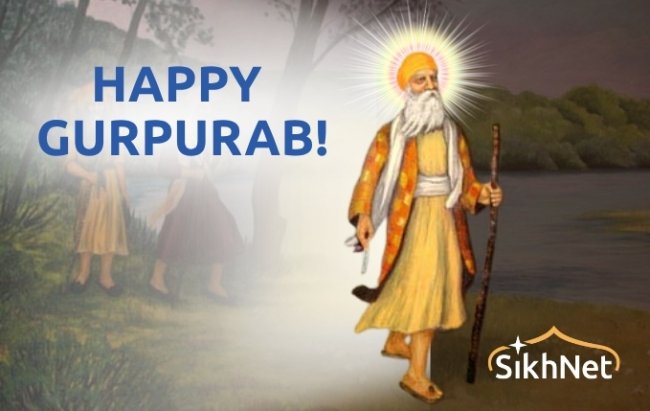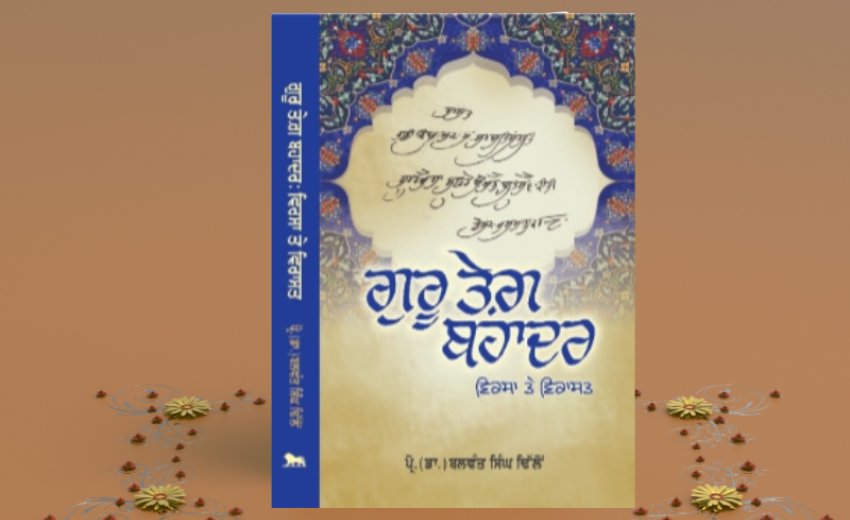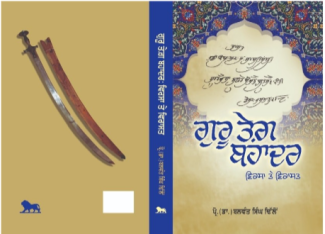Book Title: Guru Tegh Bahadur: Virsa Ate Virasat (Heritage & Legacy) (in Punjabi)
Author: Dr Balwant Singh Dhillon, Ex-Director, Centre for Studies on Sri Guru Granth Sahib, Guru Nanak Dev University, Amritsar
Publisher: Singh Brothers, Amritsar. First Edition 2022; pages: 293; Price: Rs. 550
Reviewed by: Prof. Hardev Singh Virk, #14017, 30 Ave, Surrey, BC, Canada
During 2021-22, the 400 Birth Anniversary of Guru Tegh Bahadur, nearly half a dozen books have been published by various authors. Earlier, I have reviewed two books: one written by Gurmukh Singh OBE of UK and published by the Sikh Missionary Society of UK and the other by SIKHRI Group with Harinder Singh as the lead author. Both books were written in English. The book under review is written in Punjabi by Balwant Singh Dhillon, a well - established Sikh Scholar and former Director of Centre for Studies on Sri Guru Granth Sahib, Guru Nanak Dev University, Amritsar.
The book has 15 Chapters followed by an exhaustive Bibliography. The author has devoted first six Chapters to develop the background for his volume on ninth Guru. In my view, only One Chapter was good enough for this purpose. In Introduction, author has narrated the purpose of writing this book. Guru Tegh Bahadur was born on 1st April, 1621 and became 9th Guru of the Sikhs during 1664. It was a most critical juncture of Sikh History when antagonists like Har Jee, Ram Rai and Dhir Mal were conspiring against the 9th Guru to displace him from the Guruship. On the other side, Aurangzeb was a fanatic ruler who was bent upon creating hurdles for the preaching and promotion of Sikhi by 9th Guru. It was a herculean task for Guru Tegh Bahadur to counter his adversaries both from inside the Sikhi fold and from outside, the Mughal ruler with an ani-Sikh stance.
The author has done full justice to establish the background for martyrdom of the Guru Jee, reasons for his harassment, and after-effects of his martyrdom on the history, culture and politics of India. Balwant Dhillon claims that most of the historians of Guru Tegh Bahadur failed to do full justice to his deeds of bravery and martyrdom as they based their conclusions on highly biased Persian sources or their translations done by the English without verifying the original sources. He also points out discrepancies of Sikh sources due to lack of scholarship or use of secondary sources.
In Chapter 1, author tries to establish the originality of Sikh Faith founded by Guru Nanak. According to him, Sikhi is not an offshoot or derivative of Sant Mat tradition or a syncretisation of Hinduism and Islam; it is original in its belief system, social relevance, and spiritual tradition. Guru Nanak established a Sikh commune at Kartarpur to demonstrate the working of his Sikhi principles where there is no dichotomy between the worldly and spiritual realms of life. Guru Nanak created history by bringing in revolutionary changes in the social structure of society.
Chapters 2 gives a bird’s-eye view of the contributions of the four Gurus, Angad Dev, Amar Das, Ram Das and Guru Arjun, who follow in the house of Guru Nanak. Guru Arjun compiled the Sikh scripture, a monumental work in the religious history of the world, and established it as Aad Guru Granth Sahib in Harimandir Sahib (known as Golden Temple now). The martyrdom of Guru Arjun at Lahore proved to be a turning point in Sikh history. The peaceful movement of Sikhi was transformed by Guru Hargobind into a militant movement under Miri-Piri system for defence of Sikhi. Guru Hargobind was imprisoned at Gwalior for 12 years as a political prisoner. There is no agreement on the time of imprisonment and release of Guru Jee from Gwalior fort prison. This Chapter sets the tone for coming events and a paradigm shift in Sikhi movement.
Chapter 4 describes the contemporary situation of Mughal India at the time of Guru Tegh Bahadur assuming the responsibilities of Guruship. Aurangzeb imposed harsh conditions upon Hindus by stopping their puja in temples, reading of sacred texts, and destroying their places of worship. People in general were suffering from atrocities of Aurangzeb and joining 9th Guru’s camp during his preaching tours of Malwa. Chapter 5 gives the reasons for establishment of Sikhi centre at Kiratpur, near Siwalik hills, by Guru Hargobind and occupation of Harimandir Sahib by Meenas, who did not allow Guru Tegh Bahadur to enter its holy precincts. Dhir Mal got an endowment from Shah Jahan in the form of a jagir which included town of Kartarpur as his property. Chapter 6 narrates the history of antagonism between Sikh Gurus and the Mughal rulers.
Chapters 7-15 constitute bulk of this volume and are devoted to the main theme under discussion. Chapter 6 describes the early life of Guru Tegh Bahadur and his assuming the mantle of ninth Guru of the Sikhs. His Guruship period of eleven years was full of high voltage events leading to his arrest by Mughal emperor Aurangzeb three times based on flimsy grounds. Aurangzeb was bent upon converting all Hindus into Islam. He wanted to keep Sikh Gurus under his tutelage, patronage, and subservient to his throne. However, Sikh Gurus have remained alert, independent, and opposed to the injustice meted out to the public by the Mughal rulers since the times of Guru Nanak. Guru Tegh Bahadur was fully prepared for the eventualities of his life. He got training under the tutelage of Baba Buddha, Bhai Gurdas and Bhai Bidhi Chand in basic principles of Sikh way of life and in warfare using all types of tactics for offence and defence. At the age of thirteen, Tegh Bahadur fought the battle of Kartarpur along with his father, Guru Hargobind, to defeat Painde Khan and his cohorts.
According to the author, Guru Tegh Bahadur made a wise decision to shift his headquarter from Kiratpur to Makhowal in the state of Kahlur (present day Himachal Pradesh) to avoid confrontation with other claimants from his family, like Dhir Mal and Ram Rai, to Guruship. He rechristened this township as Chak Nanki, which became a flourishing city of Anandpur Sahib after the creation of Khalsa by Guru Gobind Singh in 1699.
Guru Tegh Bahadur adorned his mantle of Guruship in end of 1664 at village Bakala. In 1665, he started his preaching tour of Malwa in Punjab. At Dhamtan in the Bangar area, Guru Jee set up a centre of Sikhi Sewa and appointed Bhai Mihan as its Sewadar assigning him insignia of Sikhi flag and a nagara (drum). His preaching tours were so successful that Mughal emperor got annoyed after receiving secret reports and imprisoned the ninth Guru. Author has quoted contemporary Assamese sources called “Ahom Boranzee” in support of this episode. Guru Jee was sentenced to death but Raja Ram Singh of Jaipur, a General of Mughal army, saved him under the plea that he will keep Guru under his custody. Ninth Guru was kept under strict vigilance of Mughal court as earlier Gurus, Har Rai and Har Krishan were kept. In a manner of speaking, Guru Tegh Bahadur was a political prisoner under the custody of Raja Ram Singh.
Guru Tegh Bahadur proceeds to preach Sikhi in eastern India in the company of Raja Ram Singh. He moves from Delhi to Patna in Bihar. There is no concordance of views on the route undertaken based on evidence available from historical sources. Author has used his discriminating intellect based on evidence recorded in “Hukamnamas” to establish that ninth Guru visited Mirzapur and Benares on way to Patna. Patna became a centre of Sikhi after Guru Jee established his family and Sikh Sangat. From Patna, he proceeded to Assam via Dhaka, now capital of Bangladesh. The author claims that Guru Tegh Bahadur went alone with his Sikh followers on his preaching mission of East India in 1966, while Raja Ram Singh was deputed by Aurangzeb to lead a military campaign to Assam in December 1967. Before reaching Dhaka, Guru Tegh Bahadur addressed Sikh Sangats at Munger, Rajmahal and Malda. Guru Jee created a Sikh Centre (Dharamsal) in Dhaka on the bidding of Bhai Bulaki Das, a masand. The Dhaka centre became hub of Sikhi preaching in Bengal and Assam. Shaista Khan, the Governor of Bengal, provided a land jagir in name of gurdwara Sangat Tola in Dhaka.
Guru Tegh Bahadur went from Dhaka to Chittagong breaking his journey at Sylhet. Guru Jee created Sikh Sangats at Sylhet and surrounding areas of Jaintia Hills, who remained attached to Sikh centre at Anandpur Sahib later on and offered valuable gifts to Guru Gobind Singh. It is a considered opinion of the author that ninth Guru returned to Patna to meet his family and Sikh Sangat. He went to Assam in the company of Raja Ram Singh. JN Sarkar writes that Guru Jee fought against the Ahom army of Raja of Assam along with the Mughal army led by Raja Ram Singh but this assumption is rejected by the author. But he is in accord with the view that Guru Jee played the role of an intermediary between two opposing armies. The peace was restored in Assam and the Mughal army failed to capture Gauhati. Guru Jee set up a Sikh centre at Dhubri before his return to Punjab. It is unfortunate that most of the remnants of Sikh heritage of Guru Nanak and Guru Tegh Bahadur in East India have disappeared.
In Chapter 10, author narrates the journey of Guru Jee from Patna to Punjab. There is no agreement on the route of Guru Jee between different sources. But there is evidence that Guru Tegh Bahadur was captured near Agra and imprisoned there on the orders of Aurangzeb. How he got released? There is circumstantial evidence that Saif Khan, an old friend of Guru Jee, pleaded for his release. After his stay in Delhi, he reached Lakhnaur on 13 September, 1670 via Rohtak, Kurukshetra and Pehowa.
The author examines the context and content of Bani of ninth Guru in 11th Chapter. Guru Tegh Bahadur wrote 59 Shabadas and 57 Slokas to preach his message of hope for the Indian masses suffering from injustice and cruelty of Mughal rulers. Judging casually at superficial level, one falls into a delusion that the message of Guru is not of hope in life but projects worldly life as full of despair and illusion. It describes the world as a mirage and transitory. This is not true. As a matter of fact, Guru Jee used metaphors of water bubble, wall of sand, mountain of smoke, mirage, shadow of cloud and dream like reality to explain human life in this world, which have been mis-interpreted by some half-baked scholars of Sikh literature.
Martyrdom of Guru Tegh Bahadur: Chapter 12 examines in great detail for the first time the various sources to determine the causes of martyrdom of Guru Tegh Bahadur. According to Sikh sources, the Guru was quite successful in his mission of consolidating Sikh Sangats in Punjab and elsewhere in India. The reports of his success were conveyed by news writers of Mughal Durbar to Aurangzeb. So, he had been kept under surveillance since the time of his preaching Sikhi in Punjab. The author has quoted Persian sources which are self-contradictory. Siyar-ul-Mutakhkherin is a historical work by Sayyid Ghulam Husain in which he records: “Guru Tegh Bahadur and Hafiz Adam, a follower of Sheikh Ahmad Sarhandi, have joined hands in Punjab. Both are collecting money forcibly from their followers. Alamgir Aurangzeb ordered the Governor of Lahore to capture and punish them”. The English historians (like Raymond, JD Cunnigham and Ernest Trump) based their findings on Sayyid Ghulam Husain and created mis-information that Guru Tegh Bahadur was a looter and a dacoit who kept an army of 2200 for this purpose. The same account has been used by Indian historians, including Fauza Singh of PU Patiala, in their books about ninth Guru. All these sources justify that Guru Tegh Bahadur was martyred by Aurangzeb due to his rebellious activities in Punjab.
The author refers to Persian sources of Punjab (Khushwaqat Rai, Sohan Lal Suri and Bute Shah) which give a somewhat different account. Sikh sources, like Bachittar Natak, Parchian Sewa Das, Mehma Parkash and Bansavlinama by Kesar Singh Chhibber, also give contradictory accounts of martyrdom. The author also refers to the most popular version of martyrdom of ninth Guru that he laid down his life for the protection of Hindu dharma. This account is based on Gur Bilas Patshahi 10 by Sukha Singh written in 1798. Ratan Singh Bhangu repeats the same story in his Panth Parkash. We can sum up this story as follows: “A delegation of Kashmiri Pundits led by Kirpa Ram reached Anandpur and pleaded with Guru Tegh Bahadur to save them from the extreme cruelty of Aurangzeb to convert them to Islam. The Guru was persuaded by his young son Gobind Rai to confront Aurungzeb for the religious freedom of Hindus”.
The author refers to the account given by Chhibber for the arrest of Guru Tegh Bahadur which almost resembles with one given by Gurmukh Singh OBE in his book: “Guru Tegh Bahadur (1621-1675): The True Story”. I quote from the book of Gurmukh Singh: “Guru Tegh Bahadur was arrested, on orders of Aurungzeb, at village Mallikpur Rangran on 12 July 1675 with his three companions, Dewan Mati Das, Sati Das and Dyal Das. They were persuaded to convert to Islam during their four-month imprisonment at Sirhind. When they refused to accept this proposal, they were taken to Delhi in iron cages and produced before Aurungzeb who failed to persuade the Guru to convert to Islam. According to Guru Kian Sakhian, three choices were put to the Guru by the Emperor through the Royal Qazi. These choices were: 1. Perform a miracle to show his divinity, 2. Accept Islam, and 3. Be prepared to die. Unhesitatingly, the Guru replied that if those were the only choices before him, then he willingly accepted the third choice".
Conclusions:
- It was for the first time in the history of religions that the Guru Tegh Bahadur was going to fight a battle on behalf of those of a belief system which he himself did not subscribe to, a belief system the basics of which Guru Nanak had rejected.
- The impact of this unique martyrdom was profound. It changed the course of the history of the Indian sub-continent, while it became the most prominent landmark in the landscape of martyrdoms for human rights and just causes in human history.
- Aurungzeb’s brutality and fanaticism had no bounds and increased as he faced more revolts in the country. In desperation, he looked for the ultimate solution in an extreme form of Islam. His tormented soul sought refuge in religious fervor and in a vision of one-religion Islamic state.
- The logic of converting Kashmiri Pundits was to convert the upper-class Brahmins, who were at the apex of the Hindu caste system, so that others would follow suit.
Creation of Khalsa by Guru Gobind Singh in 1699 was a culmination of Guru Tegh Bahadur’s martyrdom in 1675.







